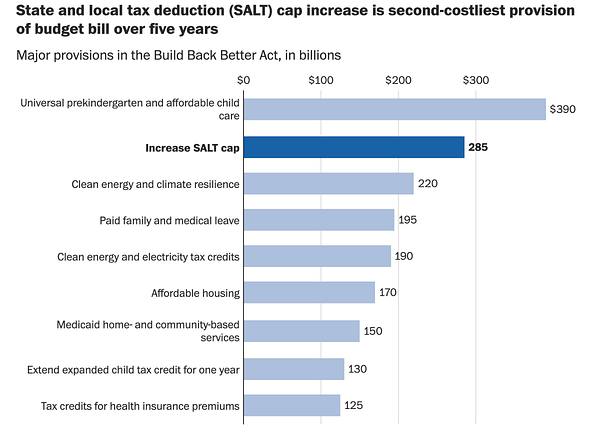I hope its shambling wreck isn’t resurrected next year, but if Chuck Schumer keeps bringing it up for a vote, and it keeps getting put back into its grave, I’m just fine with that.
Long live the SALT cap
While the Democrats keep sticking knives in each others’ backs, let me count the craptastic ways this bill deserved to die.
I haven’t been blogging public finance much, especially public finance-related bills, because the provisions keep changing. But the last I heard, the Build Back Better bill raised the SALT cap from the current $10,000 to the much higher level of $80,000.


I apologize if this graphic doesn’t match the most recent version of BBB that Schumer will try to put up for a vote in front of the Senate, but some form of SALT cap removal was in the bill, and in every version I heard of, it still was the second-most expensive item in the bill.
Also, it’s not a middle-class tax cut, for all the squawking coming from my neck of the woods.
Even the left-leaning Tax Policy Center showed that the tax cut from the SALT cap heightening redounded to those in the top 20%, and of course with higher value as one climbed the income scale. Which is what one would expect.
Here is their table:
It’s in the footnotes, but let me pull it out.
The fourth income quintile runs from $96K to $175K, so the top 20% is $175K+. The top 10% is $255K+. The top 5% is $366K+. The top 1% is $867K+.
(Those are all income levels, not wealth levels, which is a different discussion.)
Look, guys. I may be “poor” for my town, and near median for my county (I haven’t checked recently), but I am living a luxury lifestyle compared to most of the U.S. The rest of the U.S. need not be giving me a tax break for that. I knew what I was getting into when I moved to New York.
I could have decided to live a more modest lifestyle in a different state. I didn’t have to hew to a place with high-taxing ways. It’s not your fault.
Also, if we could just get the SALT cap down to zero, in which none of these state and local taxes are deductible, then there would be more pressure on New York and Westchester County and Connecticut to keep their high-taxing appetites in check.
Please, won’t somebody think of the highly-taxed? Do it for me! Set SALT cap to zero!
The pain in the short term will be nasty, but the long-term result will be worth it.
Yeah, I know that idea is going nowhere, but the $10K cap is a very good place to start.
Long live the SALT cap!
I will finish the section with a note from the other senator from West Virginia, who is a Republican, just like the governor, all the Representatives, and all the electoral votes in 2020, who links to an editorial from a West Virginia paper: EDITORIAL: TO KEEP COST OF BBB DOWN, TAKE OUT THE SALT CAP INCREASE
Speaking of Build Back Better … Moderates on the left side of the Senate aisle and all senators to the right continue to insist the price tag is too much, despite Congress slashing the cost nearly in half to appease Congressional centrists.
Well, there’s one measure in Build Back Better that the Senate is welcome to take a machete to instead of whacking away at climate and social safety net proposals: an increase of the SALT deduction cap from $10,000 to $80,000.
….
Sen. Shelley Moore Capito and her Republican colleagues have pointed out the SALT cap increase is the second most expensive aspect of the $1.75 trillion plan, to the tune of $275 billion. For comparison, the combined cost of child care and universal pre-K is $300 billion.It’s not so much money the government is spending as it is money the federal government won’t be bringing in. Although, according to H&R Block, a deduction “can result in a larger refund of your withholding.” Considering Democrats have touted Build Back Better as a bill for the average American that pays for itself, Republicans aren’t wrong to throw the word “hypocrisy” around.
As the Senate negotiates the finer details of Build Back Better before Christmas (and hopefully brings it for a vote), senators on both sides of the aisle should look to cut the SALT cap increase and restore measures that actually help the everyday people, like the dental coverage under Medicare and paid family leave that have already been cut.
I think the SALT cap should stay just where it is, thanks. Maybe make it permanent, mkay?
Just stop with the public finance accounting tricks
For what it’s worth, all the tricks that are used in public finance to make big spending bills palatable once were standard behavior in the private sector… until investors (and regulators) got savvy.
The people bitching about Manchin are saying he changed the deal, when he’s really been pointing out that they put a fake price tag in front of him, and he’s not a kid but a seasoned politician.
First, let’s put CBO scoring to one side. If one really wanted to, one could place CBO scoring up against what actually happened with various budget bills, and wouldn’t that be fun.
Okay, let’s just jump over that.
The CBO just has to pretend the bill is reality and just do the math. If the math doesn’t even work within the lies from politicians, they can’t make it work within basic arithmetic.
But politicians do know how to get around that. Tricks like: pretend the spending part lasts only 5 years, but the funding part lasts 10 years. That sort of stuff.
Or, we’ll pretend the very unpopular taxes come back in year 5, just at the point the spending program ramps up.
Also, the CBO doesn’t project past 10 years.
We have our score!
Manchin is no fool, and he noted the glaring problems with huge spending plans in the bill: that supposedly these very popular spending plans would magically just stop spending after a few years and politicians wouldn’t extend that spending.
NY Post on October 27: Dems’ Enronesque accounting is just one more sign of how inept the Biden ‘Build Back’ agenda truly is
After months of wrangling, Democrats claim they’re close to an agreement on a Build Back Better plan of $1.75 trillion over 10 years that’s completely paid for.
None of that is true. Never mind that holdout Sen. Joe Manchin says a deal is unlikely before President Joe Biden jets off to Rome Thursday. Dems’ sleight-of-hand has 10 years of tax hikes paying for just a few years of their spending.
….
What is clear is that Democrats are bent on hiding the true costs. As Brian Riedl details for The Post, “Lawmakers are crafting as much as $4 trillion worth of new initiatives but simply using fake expiration dates to score only a few years of each proposal.”
Despite the bogus expiration dates, they talk about their programs as permanent.
They want the now-temporary child-tax credit of up to $3,600 per kid to be eternal, for example, but their initial plan counted costs for four years and now they’re talking about covering just a single year.
Again, I’m not even bothering to see which of the many stitched-together wishlists actually is in Schumer’s fist right now, because it doesn’t matter.
We all know that whatever it is has a hodge-podge of a variety of taxes over ten years, a tax cut over how many years for people like me (who are in top 20% of income-earners and have decided to live in expensive places), and then a bunch of front-loaded programs that are supposed to get some Dems re-elected in 2022.
So that they can extend this spending just in time for the 2024 elections.
Uh huh.
By the way, Manchin was elected in 2018. If he decides to run again for the same seat, it would be in 2024.
What’s that about inflation?
So let’s wrap this up with a little bit on inflation.
Now, inflation is obviously a monetary phenomenon in which too much fiat currency is chasing too little goods and services. That’s grossly simplified, but essentially the case. It’s all a situation of information. If you flood a market with currency, obviously more of the same currency will be needed to purchase the same amount of goods and services, and I’ll leave the why as an exercise to the reader.
What I’m here to do is make a pretty (well, an ugly) graph for my readers.
Inflation is often measured via various indices, so let us start with one of the main indices: CPI-U, nothing excluded and not seasonally adjusted. If you follow that link, you’ll see a time series starting waaaaaaay back in 1913.
We don’t really care about the index level, but the year-over-year change, really. Yes, we could do a monthly change, but annual inflation is a more “natural” measure of inflation for us.
So, taking the long view, whoa, the early 20th century sure was crazy, wasn’t it?
But since the malaise-drenched period of the Boomers’ youth, we’ve actually had it pretty good in terms of inflation. Our most recent inflationary spike does take us back to the days of the early 1980s, but we’ve gotten pretty used to quiet times of inflation. There was another quiet period in the late 1950s/early 1960s, but it didn’t last too long.
But if we look at a histogram of these monthly snapshots of the annual inflation rates, this is what we see:
Mmmm. It was 6.8% for November 2021, by the way.
Now, there are a variety of sub-indices in the CPI-U, etc.
I have compiled a few of them and their annual changes. I’ve decided to just focus on 2000 and after for these graphs. My sources for all of these are FRED.
So let me take some of the big items:
That’s all over the place, and hard to see. So let’s really focus in on 2019-2021.
Look closely:
Electricity was flat til about September 2020, and then really started climbing.
Food had low-ish inflation, and then jumped April 2020. Slowed in growth spring 2021, but accelerated since summer 2021.
Rent and services have been kind of middling pre-2020, and moderating in 2020, and then increasing in 2021.
Medical costs stagnated in growth during the pandemic. If you know what happened during the pandemic – namely, people stopped going for non-pandemic visits in 2020 – this makes sense. Deals were cut, for obvious reasons.
So let’s look at some specific categories that don’t make up huge parts of CPI-U.
First, cars and trucks. Used and new.
See that crap back in 2010? Remember Cash for Clunkers? (thanks, Obama!)
Right now is much much worse for used vehicles. (Let’s go, Brandon!)
It’s also not great for new vehicles.
Finally, one area that used to be a bright area for consumers: electronics such as computers, laptops, devices like iPods, iPads, Kindles, etc. They used to get cheaper for the same quality.
Guess what.
That went from negative to positive, too. That crossover occurred in 2021, too.
Productivity gains in consumer electronics have not been able to exceed the erosion of the currency’s value.
Bills such as Build Back Better are just a piece of the reason — we have more coming. We have a huge demographic issue, and a huge Social Security and Medicare bill not yet paid. Shoveling out more money and writing more IOUs will not help matters.
So, RIP, BBB. Please stay dead.











